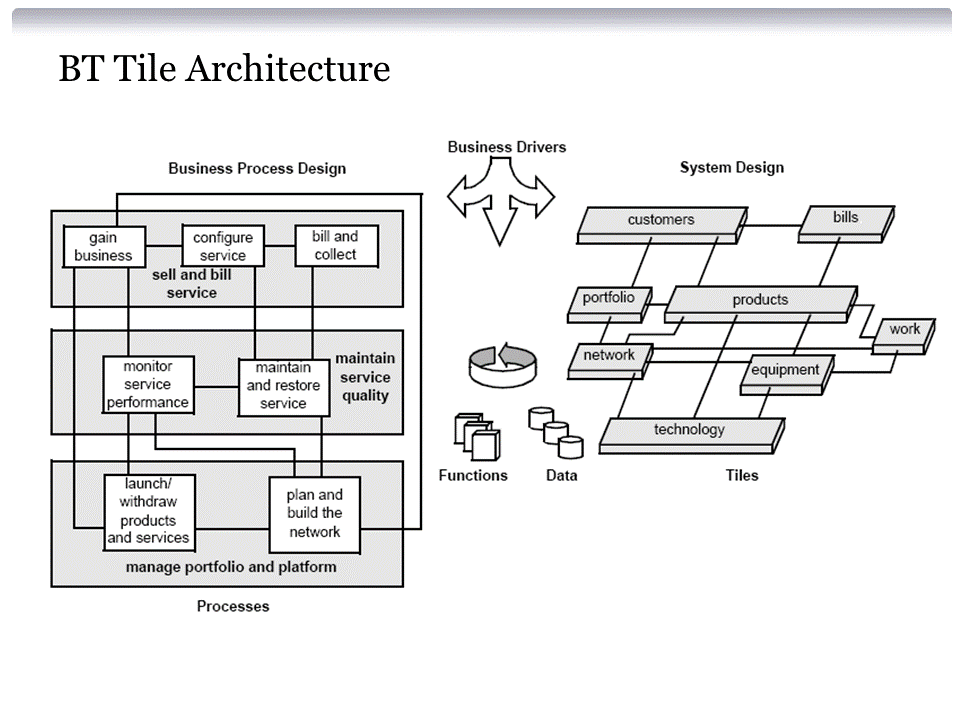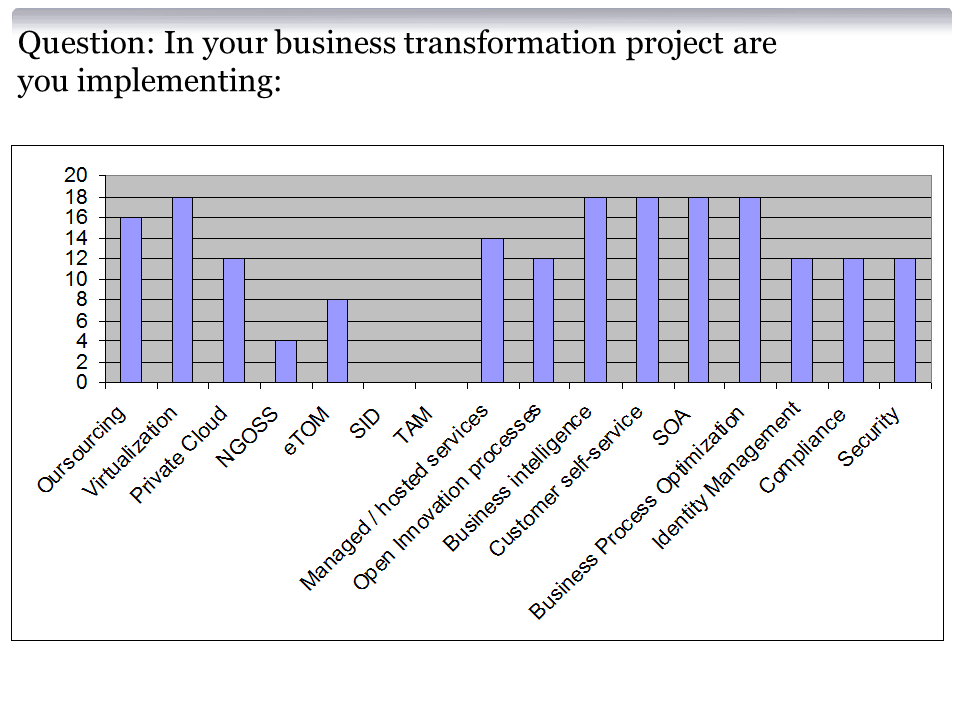TM Forum was founded in 1988 by BT and AT&T, they had created similar support system architectures, see the BT Tile Architecture shown below. Now this architecture was created nearly 30 years ago so its understandable why it suffers from the classic ‘Bell-head’ ‘box and wire’ design. The TM Forum today brings together members (700 across 75 countries) to solve systems and operational management issues. TM Forum’s Solution (NGOSS) now re-labeled Frameworx, comprise technology frameworks, one interface and one API:
- Business Process Framework (eTOM);
- Information Framework (SID);
- Applications Framework (Telecom Application Map or TAM);
- OSS / J (service management API); and
- MTOSI (Multi-Technology Operations System Interface) interface between NGOSS and network management platform.

In a market study I performed last year on business transformation, to my surprise few operators conform to the TMF specifications, most have no intention, see survey response below on the question of what operators are implementing in their business transformation projects. Even BT, the founder of TMF does not consider its architecture TMF ‘compliant.’ In discussions stimulated from the survey, the distribution of the survey’s results, and related discussions over the past year; there is significant frustration (I am perhaps being a little understated in the term I use) with the TMF:
- eTom is really only used as a common language, especially amongst the cable industry that is consolidating its silos;
- SID is considered too complex;
- TAM and Blueprint have failed to deliver common business service definitions in SOA, product and service catalog definitions. All Telcos deliver the same services: voice, video and data to pre- and post-paid customers. Commonality should be high, yet TMF has failed to deliver;
- According to the CIOs interviewed who came from industries other than telco, generally financial services, ITIL (IT Infrastructure Library) and TOGAF (The Open Group Architecture Framework) were considered more relevant to operators’ current needs;
- Frameworx is seen as a repackaging of existing specifications, its perceived as marketing spin, not progress on specifications created in some cases 10 years ago and based on nearly 30 year old ideas created at BT and AT&T; and
- TMF takes a traditional ‘box and wire’ (Bell-head) approach, rather than a service oriented approach.

ITIL and TOGAF have raced ahead of the TMF, harnessing the best ideas across the whole IT industry. ITIL has its critics, so is not the complete answer. However, Telecom is just a vertical, granted a large vertical, in the IT industry. Telco can no longer afford specials, it must leverage global volume in its solutions. ITIL has a services focus and includes capabilities like dynamic product catalog enabling operators on the fly to create bundles specific to a customer’s need, and continuous improvement, which all remain gaps in the TMF’s specs.
So what is the root problem behind the failure of TMF? Put simply, the customers of TMF are the suppliers who pay for all the TMF’s events and its profits. The operators are simply a means to an end in attracting lots of suppliers and sponsorship to the TMF conferences. The TMF’s customers are then driving the standardization agenda, which continues to run far short of helping operators break the current cycle of band-aids, custom code, and vast professional service projects for what should be configured off-the-shelf solutions. Of course, we’re led to believe that custom systems create competitive advantage, they do not. Customers’ BOSS related experiences across all operators remains undifferentiated and below the expectations created by web service providers; customers’ decisions are based on price, content (e.g. TV channels), network quality, and devices.
We need a reset on the TMF, it’s not working in the industry’s best interest. My recommendation is a split in the organization. There’s the conference organizer which is a separate commercial entity, and has no role in the definition of standards or implementation norms across the industry. Then a group of motivated operators creates a non-profit group, just like FSAN (Full Service Access Network initiative) – the group behind the globally deployed GPON (Gigabit Passive Optical Network, Fiber To The Home) system. Perhaps called BOSSIT (Business and Operational Support System IT) which defines a clear mandate with specific, measurable, time-lined, deliverables supported by the vendor community (not led) in achieving some of the following:
- Common SOA business service definitions;
- Common service definitions;
- Common product definitions; and
- Inter-operator service definitions.
Many of the above goals are well on the way to completion, in my experience there is as much as 80%+ commonality between operators expensive ‘custom’ product catalog definitions. With a forum focused on the industry’s BOSS needs, perhaps we could be saving $100s of millions if not $billions, which is necessary for telcos to compete with the web-based service providers.